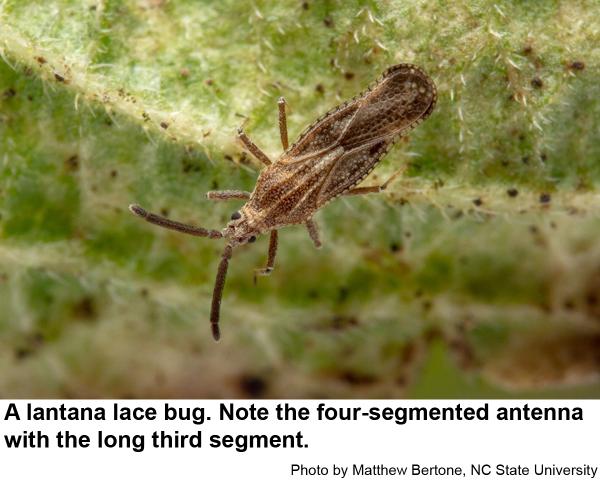Lantana Lace Bugs
go.ncsu.edu/readext?835688
en Español / em Português
El inglés es el idioma de control de esta página. En la medida en que haya algún conflicto entre la traducción al inglés y la traducción, el inglés prevalece.
Al hacer clic en el enlace de traducción se activa un servicio de traducción gratuito para convertir la página al español. Al igual que con cualquier traducción por Internet, la conversión no es sensible al contexto y puede que no traduzca el texto en su significado original. NC State Extension no garantiza la exactitud del texto traducido. Por favor, tenga en cuenta que algunas aplicaciones y/o servicios pueden no funcionar como se espera cuando se traducen.
Português
Inglês é o idioma de controle desta página. Na medida que haja algum conflito entre o texto original em Inglês e a tradução, o Inglês prevalece.
Ao clicar no link de tradução, um serviço gratuito de tradução será ativado para converter a página para o Português. Como em qualquer tradução pela internet, a conversão não é sensivel ao contexto e pode não ocorrer a tradução para o significado orginal. O serviço de Extensão da Carolina do Norte (NC State Extension) não garante a exatidão do texto traduzido. Por favor, observe que algumas funções ou serviços podem não funcionar como esperado após a tradução.
English
English is the controlling language of this page. To the extent there is any conflict between the English text and the translation, English controls.
Clicking on the translation link activates a free translation service to convert the page to Spanish. As with any Internet translation, the conversion is not context-sensitive and may not translate the text to its original meaning. NC State Extension does not guarantee the accuracy of the translated text. Please note that some applications and/or services may not function as expected when translated.
Collapse ▲This article was written by Gail Griffin, Extension Master Gardener Volunteer with North Carolina Cooperative Extension in Lee County.
Just when you think you finally found a plant that Bambi and his pals won’t totally eat to the ground, along comes a tiny, 1/8-inch insect that bursts your pretty balloon. It’s preference for the plant has earned it the name of lantana lace bug. Instead of devouring the plant all at once, lace bugs like to do it a little bit at the time.
The lantana lace bug (Teleonemia scrupulosa) is not native here, but occasionally migrates to North Carolina from areas along the Gulf coast. Their damage will most likely appear in May and June as new foliage begins to emerge. Females insert their eggs in bunches near the mid-veins on the undersides of leaves. In about a  week, nymphs hatch and feed, then develop into adults in about two to three weeks. Lace bugs are slender insects that are grayish-brown in appearance. They have dark, conspicuous antennae with four segments and their forewings form an “x” when they are at rest. They feed on the undersides of leaves and may feed on new buds and flowers. As the nymphs develop, they cast off their outer skins which may become attached to leaves. These along with dark spots of let’s say, digestive elements, indicate their presence. On the top surface of the leaves, pale spots appear. Heavily infested leaves become stippled and grayish and may drop from the plant.
week, nymphs hatch and feed, then develop into adults in about two to three weeks. Lace bugs are slender insects that are grayish-brown in appearance. They have dark, conspicuous antennae with four segments and their forewings form an “x” when they are at rest. They feed on the undersides of leaves and may feed on new buds and flowers. As the nymphs develop, they cast off their outer skins which may become attached to leaves. These along with dark spots of let’s say, digestive elements, indicate their presence. On the top surface of the leaves, pale spots appear. Heavily infested leaves become stippled and grayish and may drop from the plant.
Since lantana continuously flower throughout the summer months, they are visited by a host of pollinators. This should be considered when using control methods of lace bugs. Use of insecticidal soaps and horticultural oils should provide enough control without threatening these pollinators. Our climate can support two generations per year, so several applications may be needed. Natural predators of the lace bug, including parasitic wasps, may also help reduce the populations. Another means of control is to cut heavily infested portions to the ground. You would be surprised how quickly the plant recovers from these cuts. Be sure to remove cuttings from the site. If chemical control is necessary, contact your local extension office for recommendations. To read more on lantana lace bug, go to
craven.ces.ncsu.edu/2020/06/lace-bugs-a-potential-problem-on-azaleas-lantana-sycamores-and-other-plants/ or content.ces.ncsu.edu/lantana-lace-bug-
Sometimes when all seems right with the world, we have to have something to bring us back to reality. Lantanas are a great plant to have in the landscape. Bambi can, and will, find something else upon which to feast.
Gail Griffin is an Extension Master Gardener Volunteer with North Carolina Cooperative Extension in Lee County.




